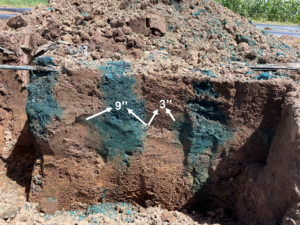A major difference between drip irrigation and other irrigation methods is that drip irrigation applies water to only a portion of the soil. This works great for vegetables grown on the plastic mulch, since no irrigation water is applied between the row middles; water applied to row middles encourages weed growth. So, does the soil under the plastic evenly wet? In some cases, as we will examine below, the soil does not become evenly wet.
Water moves downward by gravity and horizontally by capillary action when dripped onto the soil. Fine-textured soil has a greater ability to hold and retain water than coarse-textured soil. Thus, water is more likely to move horizontally in clay soils than in sandy soils. Water discharge rate of drip tapes also affects the wetting pattern. In general, water is more likely to move horizontally with high flow-rate (high discharge) drip tapes than low flow-rate (low discharge) drip tapes (Figure 1 and 2).

Figure 2. Wetting patterns for clay soils with high and low flow-rate drip tapes. (Figure 1 and 2 were adapted from https://www.fao.org/3/s8684e/s8684e07.htm#TopOfPage )
Thanks to the help of irrigation educator Lyndon Kelley, we used blue dye to demonstrate the wetting patterns of different drip tapes in a sandy soil at Pinney Purdue Vegetable Field Day. A 12’’ emitter spacing drip tape watered the soil for an hour. Assume the blue dye-covered area was where water from the irrigation event reached (Figure 3). We found the most expansive water covering area from one emitter was about 9’’ horizontally, and there was at least 3’’ spacing between wetting zones of two adjacent emitters that water did not reach. The soil was relatively wet when we conducted the demonstration. The wetting pattern would likely be wider horizontally if the soil was drier, but the gap between the two wetting zones would not likely be filled, regardless of irrigation time, given the soil moisture conditions at the time of the demonstration.

Figure 3. Irrigation dye-demonstration at Pinney Purdue Vegetable Field Day. The drip tape in the demonstration was 12’’ emitter spacing and 0.4 gpm/100 ft flow rate at 8 PSI ran for an hour at 10 PSI.
Why is it important to understand the wetting pattern? After all, one may argue, roots can follow the water pattern. As long as enough water is applied, plants should be okay even if the soil is not evenly wetted. This statement is true if only water is considered. However, water application could affect other factors. For example, suppose dry fertilizers or other soil amendments were incorporated into the beds. It is likely only fertilizers that land where the soils are wetted can be used by the plant. In other words, a large amount of nutrients may never be used if part of the soil on the bed stays dry. In another example, if one applies pesticides through drip tapes to control soilborne diseases, the wetting pattern would indicate where the pesticide is applied. Pesticides applied through drip tape will not be effective if the wetting pattern does not contact the entire root system.
We will continue discussing considerations in drip irrigation in a series of future newsletter articles.
Funding for project Improve Drip Irrigation Management for Vegetables and Melon Production in Indiana was made possible by the Indiana State Department of Agriculture through grant A337-22-SCBG-21-003. Its contents are solely the responsibility of the authors and do not necessarily represent the official views of the ISDA.
